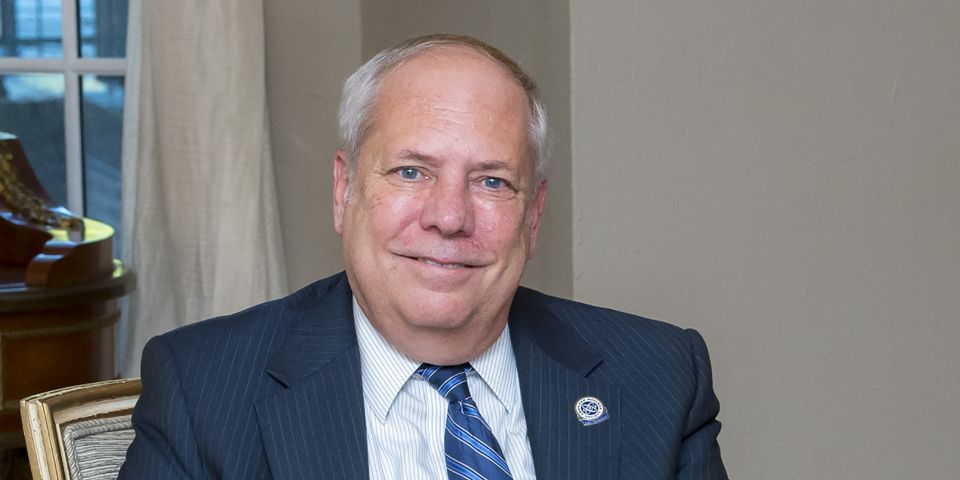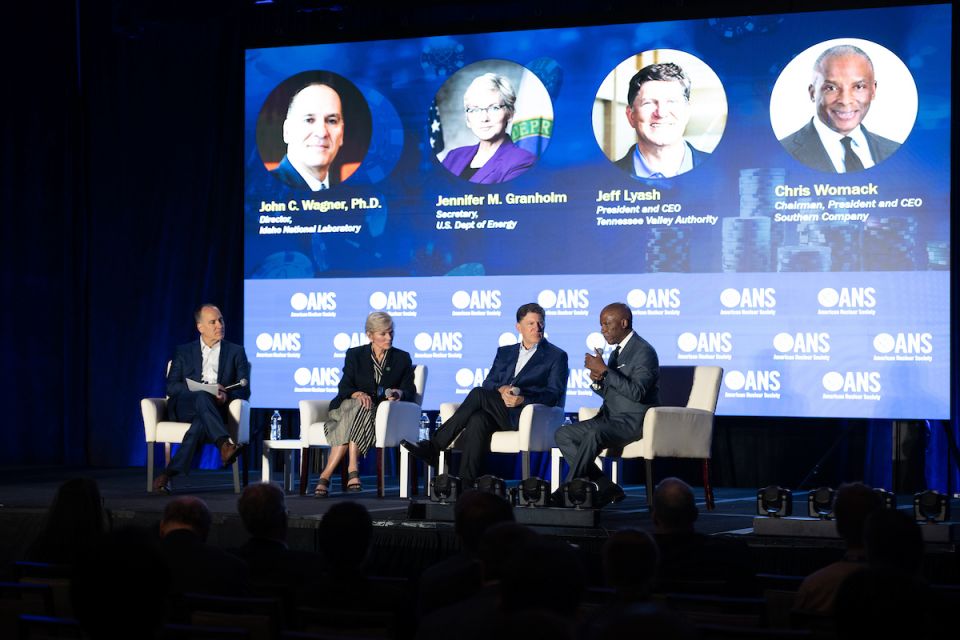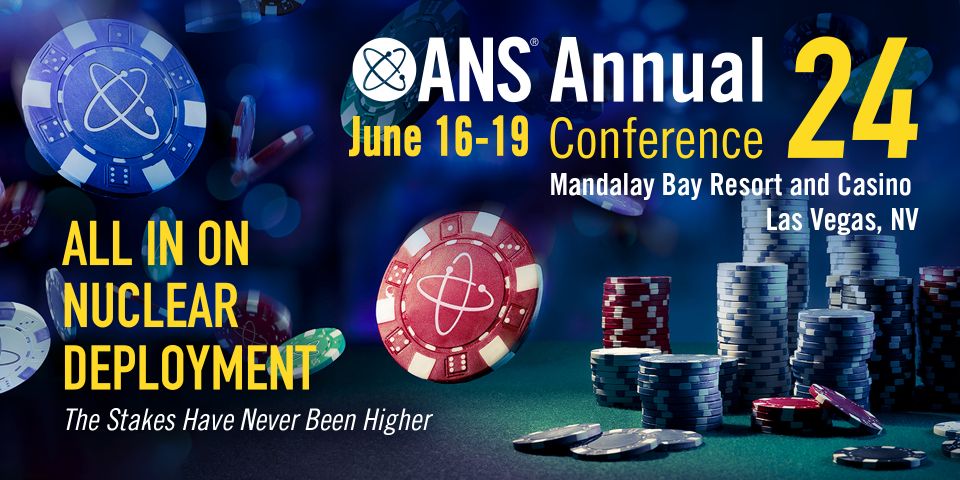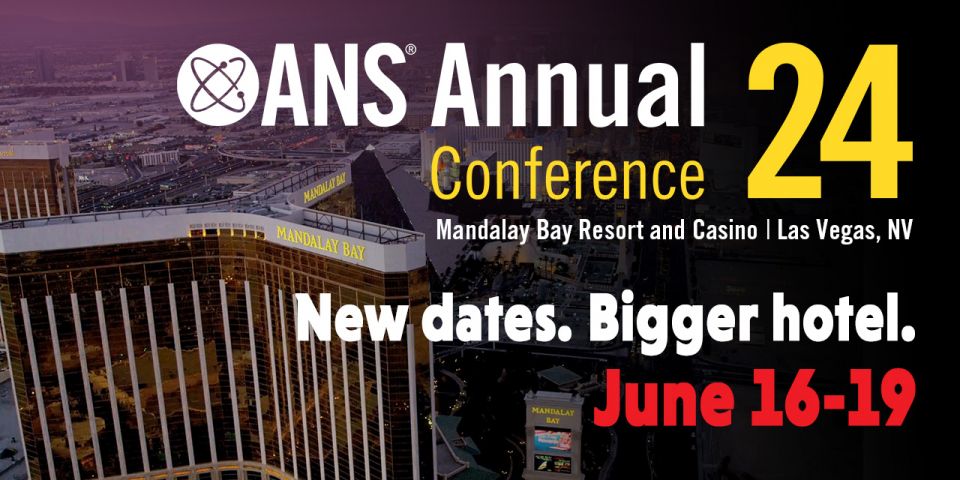Past ANS president Edward D. Fuller passes away
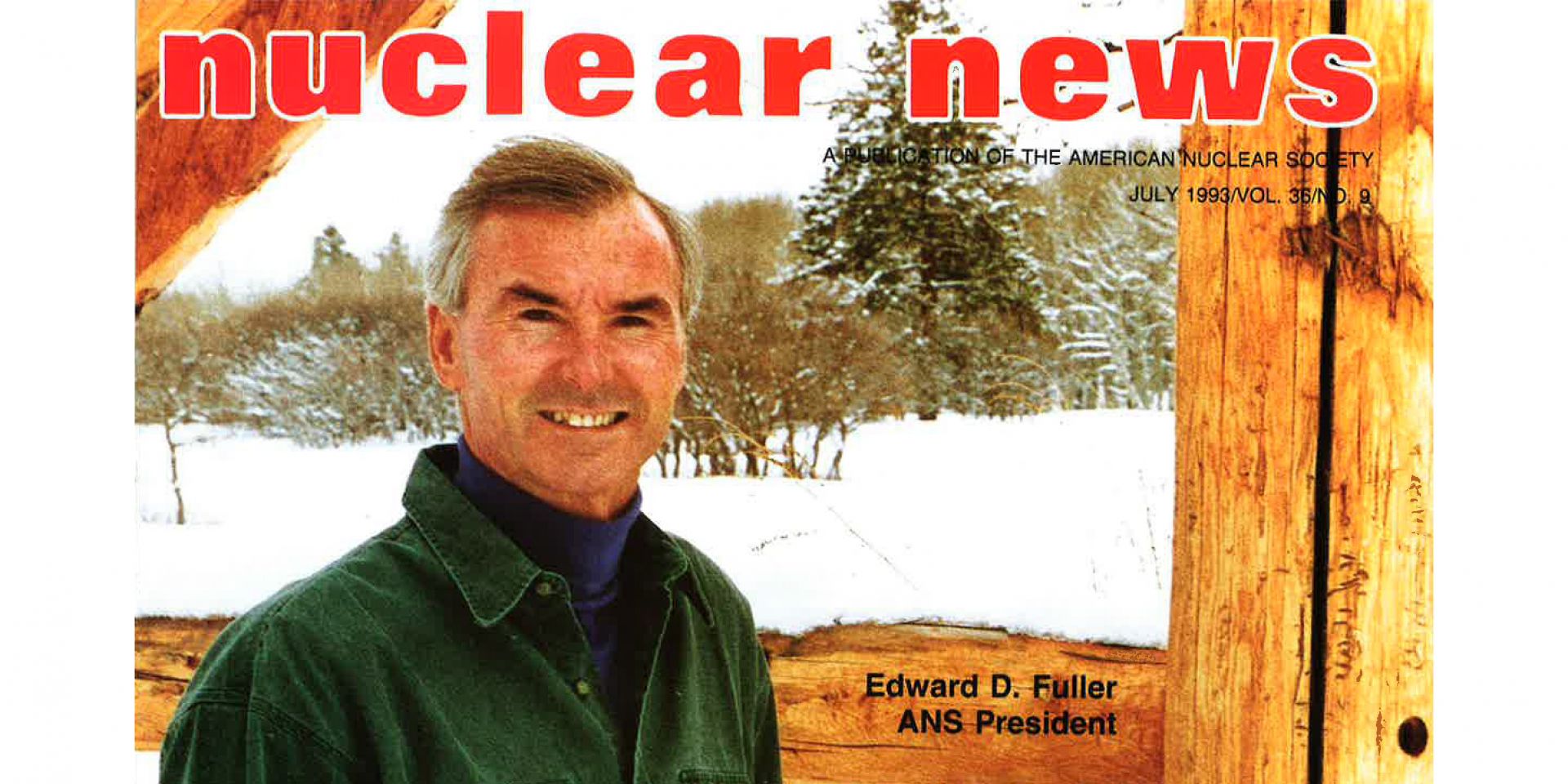
Every year in July, ANS introduces a new president to its membership. Thirty years ago this month, it was Ed Fuller. Fuller joined ANS in 1966, was named a Fellow, and served in numerous leadership positions in ANS committees, divisions, and on the board of directors prior to becoming president in 1993. Last month Fuller passed away at the age of 82.
Lasting legacy: Republished below is the profile of Fuller from the July 1993 issue of Nuclear News. Reading through his profile about Fuller’s time with ANS, it is clear that he was a thought leader whose ideas about the future of nuclear and its benefits for humanity ring true today. Fuller believed that the us-vs-them mentality of nuclear advocates and environmentalists was detrimental to the environmental movement. Although there has been some improvement in the rhetoric over the past 30 years, Fuller’s belief is still accurate—nuclear energy is one of the most environmentally friendly ways to generate reliable power.
Fuller states in his profile, “Once you have figured out the raw numbers [of power needed in the future around the world], it’s easy to make the case that nuclear energy will be essential to help provide that energy, because world fossil reserves will not be sufficient, and renewable technologies are not advanced enough to cover the gap between available supply and projected demand.”
Fuller also discussed other challenges that faced the nuclear community 30 years ago that will sound familiar to most ANS members today, such as how to grow membership by drawing from the hundreds of thousands who work in the nuclear community. Fuller knew then that the most important part of the community is its people.
Memorial: Fuller's wife Nancy announced his passing on social media saying, "He was a great father, grandfather, friend, husband and a force to be reckoned with on many fronts. [He] loved his family, his career in nuclear energy, snow and water skiing, biking, and above all else, a challenge." A celebration of Fuller’s life will be held for friends and family at his Colorado mountain home on September 30. Write in to nucnews@ans.org to share your memories about Fuller.
Ed Fuller: The greening of ANS
by Nancy J. Zacha
With all the rhetoric about alleged hostilities between environmentalists and nuclear energy proponents, it’s been difficult to keep in perspective the fact that pronuclear people are environmentalists. Nuclear energy is one of the most environmentally friendly ways to generate electricity today. Somehow, this message has gotten lost in decades of demonstrations, protests, and litigation.
One person who hasn’t lost sight of this fact is Edward D. Fuller, the 1993-94 president of the American Nuclear Society. A California native, Fuller comes naturally to the environmentalist image. Most likely, his concern for the environment stems from his roots in the Old West.
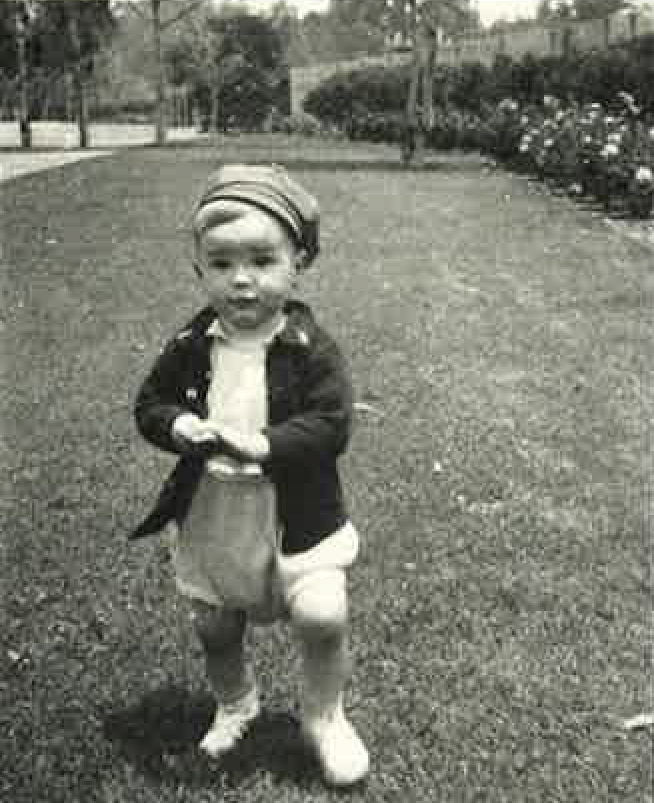
No, it's not Spanky of Our Gang-it's Ed Fuller in 1942
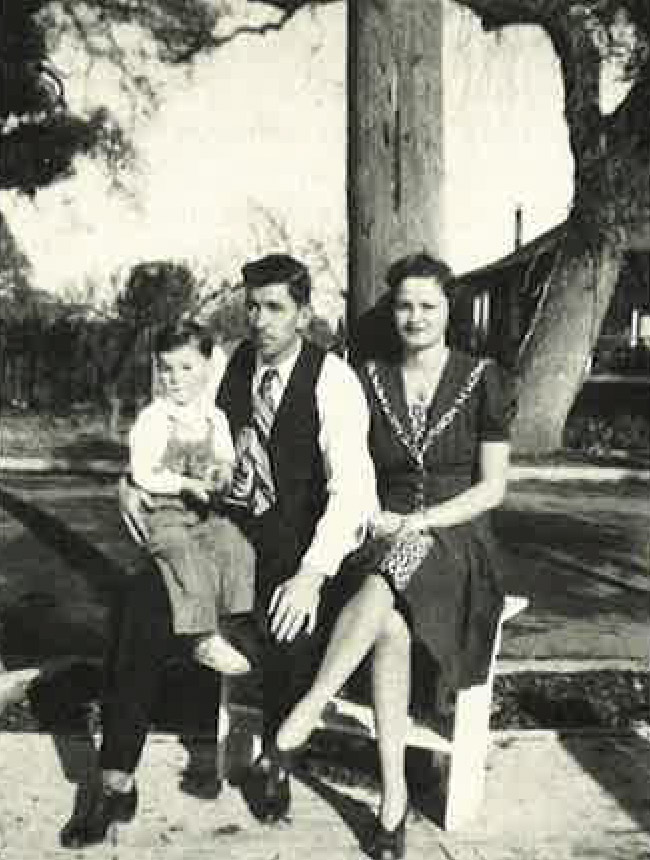
Ed, his father and mother-in 1943
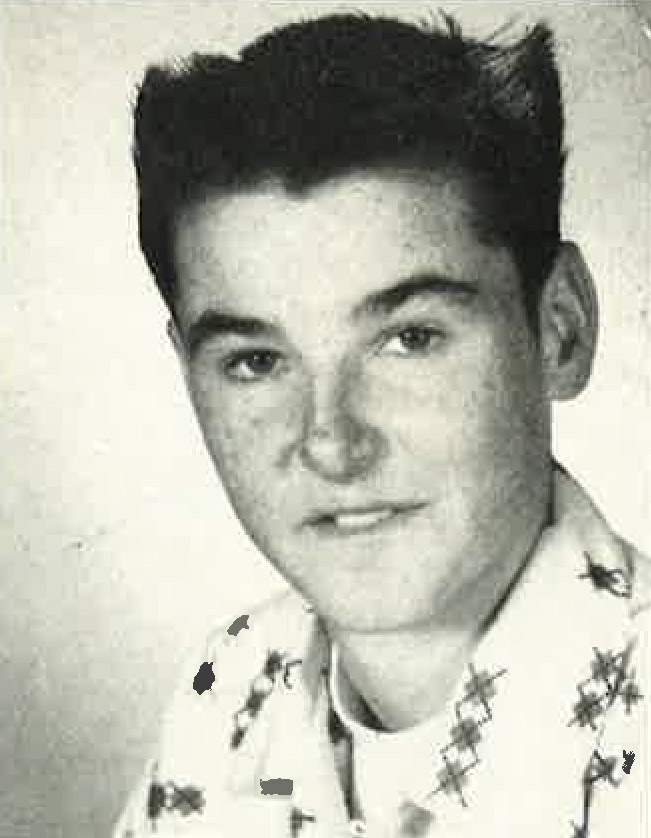
A freckle-faced young teen-1956
ln the beginning: Both of Fuller’s grandfathers were ministers, among other things. His paternal grandfather was a buffalo rider and trainer for the Buffalo Bill Circus. But he also traveled all over the southern United States as an Evangelical minister, and served for a time as chaplain for the cowboy's association. “He led an exciting, Rough Rider kind of life,” Fuller notes.
His mother’s father was also a minister, living all over the country working in and leading churches for the Assembly of God ministry.
“My mother grew up in Iowa, and my father grew up in North Dakota. They later moved to California, and that’s where they met,” Fuller states. Glenn Fuller and Violet Hannan married in 1940 in California. Ed Fuller was born in Berkeley on April 16, 1941.
“My dad was working in the shipyards as a carpenter during World War II, and he was about to go into the service when the war ended in 1945. After the war, they stayed in California, so that’s where I grew up. When I was about six, we moved to San Jose, and I have maintained my primary residence in the San Jose area since then.”
Fuller attended James Lick High School in San Jose, where he was actively involved in sports, basketball, baseball, and football, and dated the head cheerleader. “Most of the kids in the school were not academically oriented,” Fuller recalls. “The school was in an agricultural, mostly minority community, and there wasn’t much motivation to go to college. In fact, I didn’t even think I was going to go to college-my Parents weren’t pushing me to go, for instance. But for some reason, when I graduated, I couldn’t think of anything else to do, so I decided to go to San Jose State University, which is the school in the neighborhood.”
Once enrolled in college, Fuller had no clear view of future career plans. As he describes it: “I was originally an engineering major, but I couldn’t get any engineering classes, so I changed my major to mathematics. Then at the end of my freshman year, I won the Outstanding Freshman Chemistry Award for work I had done in my chemistry classes, even though I wasn’t a chemistry major, so I figured I’d better major in chemistry.”
Just when his life seemed to need guidance the most, fate stepped in to help him find direction. Many people tell stories of a seminal moment that changed their lives forever. Fuller’s story centers on going to buy a sports car.
MG, GE, BS, MS...
“I’ve always liked sports cars,” Fuller explains, “and during the summer between my sophomore and junior years in college, I answered an ad in the newspaper that offered an MG roadster for sale. My parents went with me to look at the car. While my Dad and I were looking at the car, my mother was talking to the man who was showing the car—he was selling it for his brother, actually.”
“And my mother, being proud of me as mothers tend to be—began to tell this man what a great student and hard worker I was, and pretty soon he got very interested. Without my even knowing it, he and my mother negotiated my joining General Electric Company as an engineering assistant.
“The man selling the car-and who offered me this job-was Russ Crowther. He passed away several years ago, but throughout his life, he was a good friend to me and a good mentor. I worked directly for him for about six years at GE, until I went on to do other things. Russ was also very active in ANS, and he got me involved in ANS and encouraged me to take my first trip to a national meeting in Gatlinburg, Tennessee, back in the early ‘60s.” Now working part-time at GE, Fuller changed his major one last time to physics, because that was more in line with the work he was doing at GE. In 1961., he married his high school sweetheart-the head cheerleader-Judy Pratt. In 1962, he graduated from San Jose State with a bachelor’s degree in physics, magna cum laude.
After graduation, he qualified for the Stanford Honors Program. With GE support, he spent the next two years working and attending graduate school at Stanford, earning his master’s degree in nuclear engineering in 1,964.
“Russ was a real supporter of my getting advanced education,” Fuller notes. “I wasn’t necessarily motivated toward additional education-I was married, had a job, and I came from a background of people who were totally happy with that kind of life. But Russ and the people around me at GE-people like Rudy Kanne, who was one of the original participants in the Manhattan Project and who ran the physics group at GE in the early’60s-were great motivators.”
Continuing at GE
Fuller was working in the Conceptual Reactor Physics Design Group at GE. This group was responsible for developing the designs for the fuel bundles used in GE boiling water reactors. “Russ was the spiritual leader for the innovative design concepts,” Fuller recalls. “He’d be up brainstorming in the middle of the night-he worked all the time—and then we in his group would go out and calculate or demonstrate whether his ideas would work. We worked on special lattices, all kinds of configurations of fuel, water, and structural materials. We were the first group to propose and actually complete the designs for gadolinium fuel assemblies. Now it’s done all the time.
“Those were wonderfully exciting times,” Fuller continues. “In those early days, everybody did a lot of things, we weren’t pigeonholed into very small functions. I did everything from fuel to thermal-hydraulic designs to writing computer programs. The first computer I worked on at GE was a Philco-2000, which filled a huge room at the company. At the time, it was an advanced state-of-the-art unit, and we needed something that big to run the codes we were developing. Today, you can get the same capacity in a laptop computer.”
The GE spirit extended to the personal lives of the employees. “One of the things that made GE such a strong team was that the people in the advanced engineering program all socialized together. We started out as poor starving students and engineers. We shared a sense of the company’s progress, and of our own progress as well, as our families grew.” The Fullers had three daughters over the next few years-Debbie, born in 1963; Julie, born in 1965; and Beth, born in 1968. “It was fun to see all our kids grow up together. We formed some strong bonds, and a lot of us still see each other, even though most of us no longer work for GE.”
When he finished his coursework at Stanford, he joined the GE Advanced Engineering Program. “This is a program known well by most GE graduates,” Fuller explains. “It’s a three-year program of advanced engineering study whereby people within GE could advance their practical engineering capabilities. People within GE would come and teach classes in all kinds of engineering disciplines, electromechanics, fluid flow, structural engineering, practical engineering analysis. It’s a pretty intensive program.” Fuller took the first two years of the three-year course in one year, completed the third-year course the second year, and then supervised the program in the third year. “That got me interested in teaching and communicating,” he says.
“And that pretty much topped out my technical educational experience, except for the studies that everyone does over time. In addition, though, GE has a great program of continuing education and management skills training that select people have the opportunity to go through. GE picks people from various divisions to go through the fast-track programs, and I was fortunate enough to be picked for these programs as well.”
Now finally able to devote full-time energies to GE, Fuller went to work with Bob Brugge, who was in charge of fuel management services for GE BWRs around the world. His first assignment was to visit all of those reactors-there were about seven at that time. “I had never been out of the country,” Fuller notes, “and I got pretty pumped up about the opportunity to travel to India, Germany, Italy, and to parts of the United States where I had never been, like Michigan. I began to visit those plants to help them with their fuel management services.”
Later, in the early I970s, Fuller switched to proposal engineering work at GE, working with Walt Wolf. Wolf was active in the ANS Fuel Cycle Division, and got Fuller interested in working with the division. Fuller’s first elected office within ANS was on the Fuel Cycle Division Executive Committee in the early 1970s.
“The nuclear power business was just starting to blossom then,” Fuller recalls. “Improved reactor designs were being sold by GE, by Westinghouse, and others, and we were all running around the country trying to talk utilities into buying our products. So I spent a lot of time traveling, first on fuel proposals, and later in the total nuclear steam supply system proposal area. This got me into another aspect of communications that I really enjoyed—technology communications, which is a form of teaching as well.”
Fuller was also involved in the conceptual design work of the later GE BWRs. “We were optimizing designs to meet utility needs and trying to improve economics and doing everything in a rapid time frame to be competitive. And we were successful,” Fuller notes. “We were selling some 20 nuclear systems a year. Not all of those were built, of course, because of the change in demand for power and because of changing economics, but it was a time of really exciting conceptual design work. There was a lot of immediate feedback on the work you were doing. And there was a spirit of teamwork then that is missing in the work being done today. I’m very interested in team-building concepts, and a lot of my interest in that comes from my memories of those days at GE.”
By the mid-’70s, however, the nuclear power market began to go flat. Fuller moved over to the licensing end of GE’s BWR business and headed that effort for several years. During that time he remembers that he spent most of his time on the road, in the process setting the record for the number of trips back and forth from San Jose to Washington. “One week in particular,” he recalls, “I was in Washington Monday and Tuesday, flying back on Tuesday night. But I got a call at home telling me they needed me back in Washington the next morning. So I hopped the red-eye that night and was back for meetings the next morning. I also remember going on a trip to Brazil where I flew down to Rio de Janeiro from San Francisco, that’s a 12-hour flight, by the way-gave a two-hour presentation, and then returned immediately to San Francisco, because we had other proposals to make or another meeting to go to. I think I was sick for about a week after that trip. It was an incredibly busy time.”
Moving on
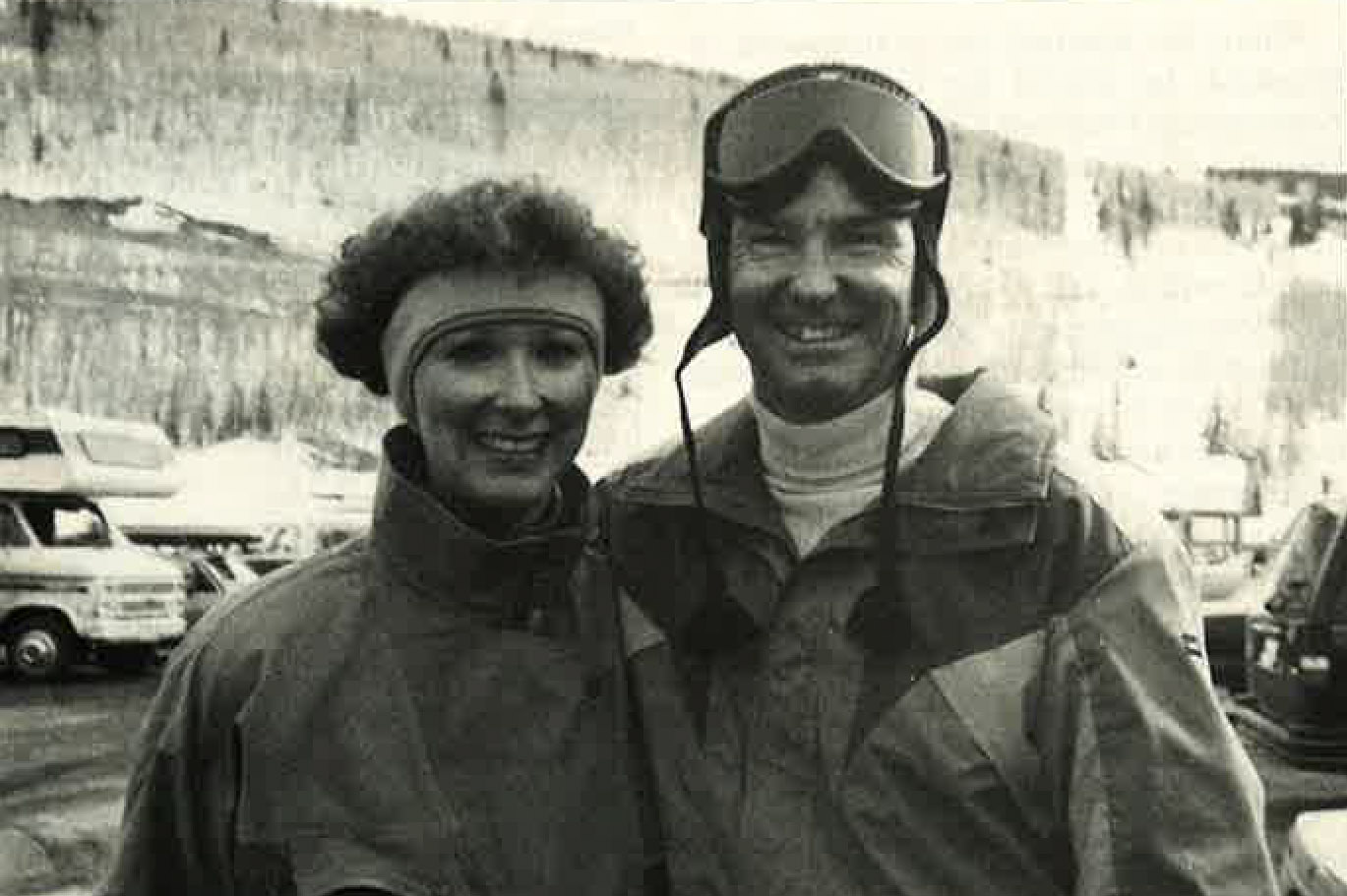
Nancy and Ed ready for the ski slopes
In 1978, Fuller left GE. “There had been a change within the leadership of GE,” he states. “Sol Levy, whom I had worked under for many years and who was probably the best engineer that I have ever known, asked me to join him in a new company that he was forming, S. Levy Inc. So I did, because I saw the opportunity to work closely with him and to learn his approach to problem solving, utilities, and new business development. And I was excited about getting into the consulting business, something I had never done before.
“At that time, there were a lot of projects going through the construction phase or working on getting their construction permits,” Fuller continues. “My first significant assignment with Sol was work on the hearings for the Public Service Company of Oklahoma to get the CP for the Black Fox station. We had tremendous battles with antinuclear forces on Black Fox, and we were successful in defending the adequacy of the station. The hearing record had closed, and the unit was within days of being granted a construction permit when the Three Mile Island accident occurred. That put a total stop to the proceedings. The hearings were reopened two years later, and ultimately the project was canceled.”
The TMI accident, while it was devastating for the U.S. nuclear power industry, did provide work for hundreds of nuclear engineers from around the country. Fuller was assigned to work on a project to analyze the root causes of the TMI accident to help the Nuclear Regulatory Commission develop a rational approach to recognize and address potential severe accidents in the future.
“When I first heard the news about TMI,” Fuller admits, “I was in southern California, and my first reaction was that it was no big deal. I called Sol first thing that morning, and he said he was on the way to TMI, and suddenly I realized that it was a big deal. During the next several years, I spent a lot of time at the island, I essentially took up residence there. I still go back there on occasion.”
In the early weeks and months after the accident, Fuller recalls, those working at TMI had no idea of the actual core condition. They knew there was probably a great deal of core damage, but the true extent of the damage remained unknown. Fuller was part of the team that planned and carried out the first video inspection of the core. “The first visual feedback of the condition of that core was a real revelation to a lot of people the damage was just so extensive-and to be there to see that first-hand was pretty exciting.”
Fuller also worked on the containment venting plan. “We came up with all kinds of screwball ways to vent the containment. The goal was to get the venting point as high up in the atmosphere as possible so as to get as much dispersion of the radioactive gas before it would get down to earth levels. One idea was a huge suspended sausage funnel that would connect to the containment. A huge balloon would raise the sausage funnel and suspend it above the smoke stack, and then they would pump the gas up through that funnel to release it in the high elevations. Ultimately, we decided that was too impractical.”
Again, it’s the team experience that impresses Fuller most about his years working at TMI after the accident. “A thousand people came to town, and they were housed in the warehouse at the airport to keep the congestion down at the site. Men and women from GE, Westinghouse, Babcock & Wilcox, and Combustion Engineering----engineers from all over the country came to guide initial stabilization at the site. “Just two weeks before the accident, my wife and I separated. That was the start of my single life.”
Eventually, Fuller left S. Levy Inc. to form his own consulting company, Associated Project Analysts. He worked there from 1986-1991, building the company to a size of 15-20 employees at one time. But he missed the larger consulting company environment, and in 199l joined Tenera to become part of Tenera’s larger consulting group.
In recent years, Fuller has continued to work on regulatory challenges, particularly at the industry’s problem plants. He worked for several years at the Tennessee Valley Authority, helping to resolve the regulatory issues at Sequoyah, Browns Ferry, and Watts Bar. “Watts Bar was in a particularly rough spot because they did not have an operating license at the time the whole TVA nuclear system shut down. The utility was plagued with problems of communication and chain of command, Problems of employee trust and understanding, and a whole range of organization management problems. Before Watts Bar could be completed, all these issues had to be addressed, and a complete reexamination of the construction of Watts Bar had to be undertaken. They are just now completing a large part of that work-seven or eight years later. The plant is scheduled for an operating license sometime in late 1994, I’d guess-meaning an eight-year program to finish a plant that was 95 percent complete at the time it was shut down.”
A lot of lessons will come out of the TVA shutdown, Fuller believes. “Because of TVA’s challenges, we’ve gained a greater appreciation of what causes a nuclear power program to go sour-it’s people, not the technology and not the hardware. We’ve learned how people work together as a team, how they respond to challenges, how people are motivated, how they communicate with each other. Those are the fundamental issues our industry faces today, and they are the same kinds of problems facing ANS----education, understanding, teamwork, motivation. I have been really fortunate in being a part of these programs where I have learned so much.”
More recently, Fuller’s time has been spent primarily on a project for Tenera at the Rocky Flats production facility. “That involves a whole new set of challenges,” Fuller explains, “though with the same basic problems----communication, understanding, teamwork, team building, trust. The Department of Energy has a lot of facilities that were once involved in defense work that are now going to be decommissioned, and a lot of people are confused about what their future is and how they are to go from a production environment to a decontamination and decommissioning environment. We’re trying to help DOE identify the standards that should be applied to those kinds of activities. So we’re transferring the commercial nuclear industry experience of the past 30 years to another organization that has been operating in a totally different way. Sometimes you get the impression that they think they don’t need the kind of experience the nuclear industry has developed. It’s been a tremendous challenge.”
Today, Fuller spends his time managing the Electric Utility Group and developing corporate strategy for Tenera.
Tenera has been very supportive of Fuller’s ANS activities, he notes. “They deserve credit for making me available for ANS functions. As we all know, my duties as vice president/president-elect have taken a lot of time, and the year as president will take even more. But Tenera appreciates the opportunity to contribute to the industry that they are a part of.”
Looking ahead
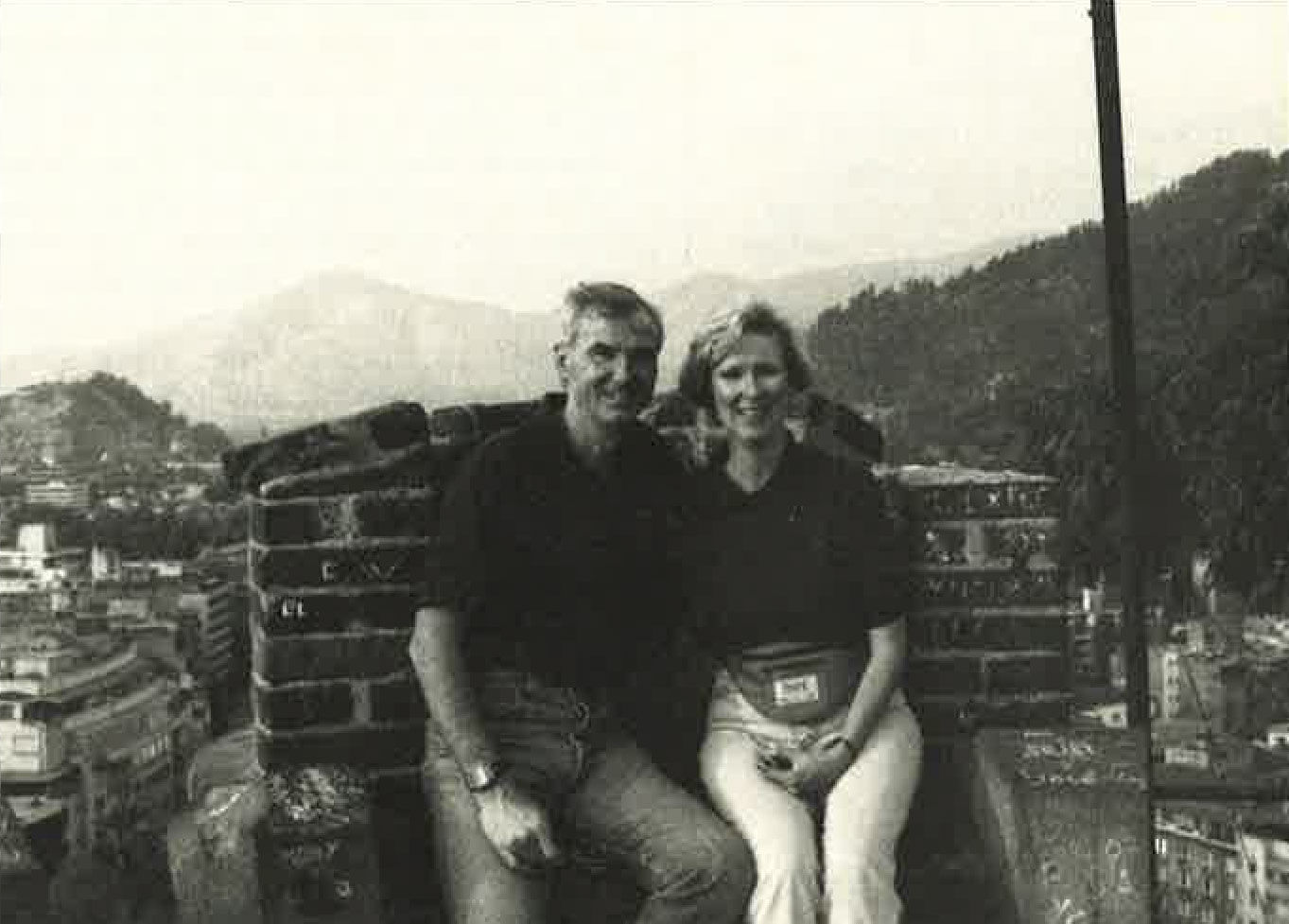
Ed and Nancy in Santiago, Chile, in November of 1992.
As mentioned above, Fuller became involved with ANS at an early stage in his career at GE. “Russ Crowther originally stimulated my interest in the American Nuclear Society, and encouraged my continued involvement. My experiences at the first national meeting I attended convinced me that I needed to begin an involvement with ANS. I became a member, contributed papers for a number of years, and became involved with the Fuel Cycle and Power Divisions. And through ANS, I’ve made some very lasting friendships-for instance, George Coulbourn, who I climb mountains and ski with; John Graham, who I run with; and Jon Stouky, who is serving as my assistant this year.”
Fuller has served on division program committees, “which gave me a tremendous appreciation for the work it takes to put programs together for national and topical meetings.” His years of service to ANS also include terms as chair of the Fuel Cycle Division, vice-chair of the Power Division, chair of the Professional Divisions Committee, chair of the Public Policy Committee, ANS Treasurer, and ANS Board Member.
“However, my most important contribution to ANS,” he notes (tongue-in-cheek), “has been in helping John Graham put together the fun run. John and I started running together at the Toronto meeting in 1976, and we would run together at every national and winter meeting–it was the only time we would see each other, at ANS meetings. And we have a nearly unbroken string of running together at every ANS meeting. There was a group of runners that continued to come to meetings and run together, and after a few years of getting together casually, we started the fun run. Since then, we’ve had up to 40 or 50 runners show up at 6:30 on Tuesday mornings during ANS meetings to come run with us. It’s absolutely for fun, and we’re disappointed that we don’t get more runners out. I think physical health is a big contributor to mental health, so I try to encourage everybody to get exercise, even in the high-stress national meeting environments. And we have a lot of fun, running together.”
During his year as ANS president, Fuller is looking at ways to enhance the activity level of all ANS members. “There are about 200 000 people that are involved in the nuclear community, and we are a professional society, and we have fewer than 20 000 of those. There must be something more we can do to make our membership grow, to make people more aware of why it’s important to be a member of ANS.
“One key for the future is to offer more programs that deal with environmental restoration and waste management, where many potential new members will be working,” he notes. “National laboratories and plant sites offer great opportunities as well. In fact, we’ve done a great job through the new plant branches in attracting members from the utilities at the plant sites. But we need to energize the local sections. Often, what makes a local section successful is one or two people, and if you lose them, you lose the whole forward motion of the section. We have to find ways to stimulate people to lend support. I firmly believe that the stronger the local sections, the stronger the national program will be.”
International issues are another area of interest for Fuller. “Many people feel that with all the challenges there are in the U.S. nuclear program, we can’t spend a lot of time on an international program. But I have learned that we are well respected in the international community, and we must continue to support and maintain that respect, because once you lose it, it’s very difficult to get it back. The ties you make professionally and technologically to the nuclear cause are very important to overall world peace, cooperation, and understanding. We can make ties in ways that governments can’t. I am really proud of the work that many people have done within ANS in making those ties and keeping them under difficult situations. The work we’ve been able to do with Russian scientists and for the former Soviet reactor program, for instance, has given me a true appreciation for the importance of our international efforts.”
Fuller’s interest in international affairs ties in well with his interest in the concept of world sustainable development. “If you want to make projections of future energy needs, you have to start with certain assumptions,” he explains. “If you assume that you are going to try to raise the standard of living of the Third World, for instance, you can project how much energy it is going to take to provide that increase. Once you have figured out the raw numbers, it’s easy to make the case that nuclear energy will be essential to help provide that energy, because world fossil reserves will not be sufficient, and renewable technologies are not advanced enough to cover the gap between available supply and projected demand.”
On the run
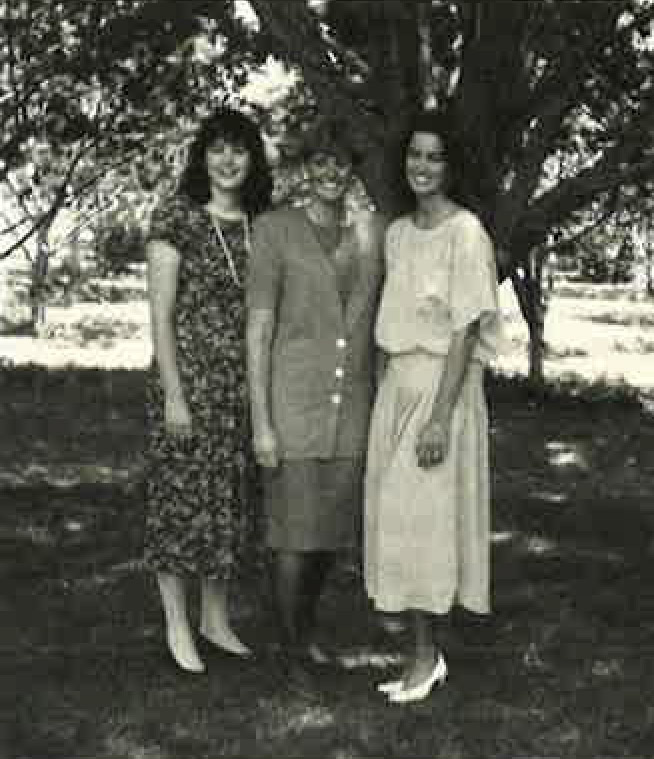
The Fuller daughters (left to right): Julie, Debbie, and Beth
If Ed Fuller sounds like a man always on the run in his professional life, it should come as no surprise that he is equally active in his personal life. He played on several sports teams in high school, played industrial league basketball at GE, and began running in 1972. In the past, he has run several marathons, including those in Boston and New York, but today he concentrates on what he calls “casual running”-which he defines as about 40 miles a week.
His other sports activities include water skiing; “last year my boat burned down, but I’ve gotten a new boat, because the kids really love to water ski”- and in the winter he is an avid snow skier. He lives in Los Gatos, Calif., and has a vacation home in Telluride, Colo. “My younger brother Mark and my parents live near Telluride, and my brother and his three sons are expert skiers, always challenging me to greater success in skiing. I also like mountain hiking, backpacking, snowmobiling, and trail bike riding.”
Fuller’s three daughters are now grown. Debbie, age 29, is a registered nurse and is completing her master’s degree work at the University of California- Santa Barbara. She and her husband, Ken Delos-Santos, who also graduated from UCSB, are preparing to join a foreign ministry as Christian missionaries in Slovenia. Julie, age 27, is the management information systems officer for the Canadian consulate in southern California. She has a degree in computer science from UCLA, and is married to small daughters. Fuller’s youngest daughter, Beth, has just finished her graphic arts degree at the University of Central Florida.
Last November, during a trip to South America, Fuller officially ended his status as a single male-he proposed marriage to Nancy Woodard, a woman he met several years ago in Tennessee. Nancy now lives in California and is director of new business development for the San Jose Mercury News. “We were in Santiago, Chile, and we walked into a little chapel on top of San Cristobal Hill, and it was such a spiritual place that I felt that if I were ever going to propose, this was the place to do it. I asked her to marry me, and she accepted. We’re going to be married after my ANS presidential term. She is a great outdoors person like me, and she loves the snow, the mountains, the birds, trees.”
Talking of the mountains makes Fuller somewhat pensive. “I don’t understand why people do not accept the value and the environmental benefits of nuclear power-maybe they are too tied into their antinuclear, antigrowth, or anti-energy special interests. Nancy and I both travel a lot, so we don’t see a lot of each other. Most of our time together is spent in the mountains, where we can just reflect on where we are all headed, on what this world is all about, and what role nuclear power plays in it.”
Fuller’s duties as ANS president will take him around the country and overseas. This year will give him the chance to spread the word about all the benefits of nuclear energy, but most particularly the environmental ones. It’s a role he’s long been preparing for, and a cause for which he cares deeply. ANS is sure to benefit.
Nancy J. Zacha was director of public communications at ANS, and a contributor to Nuclear News.


